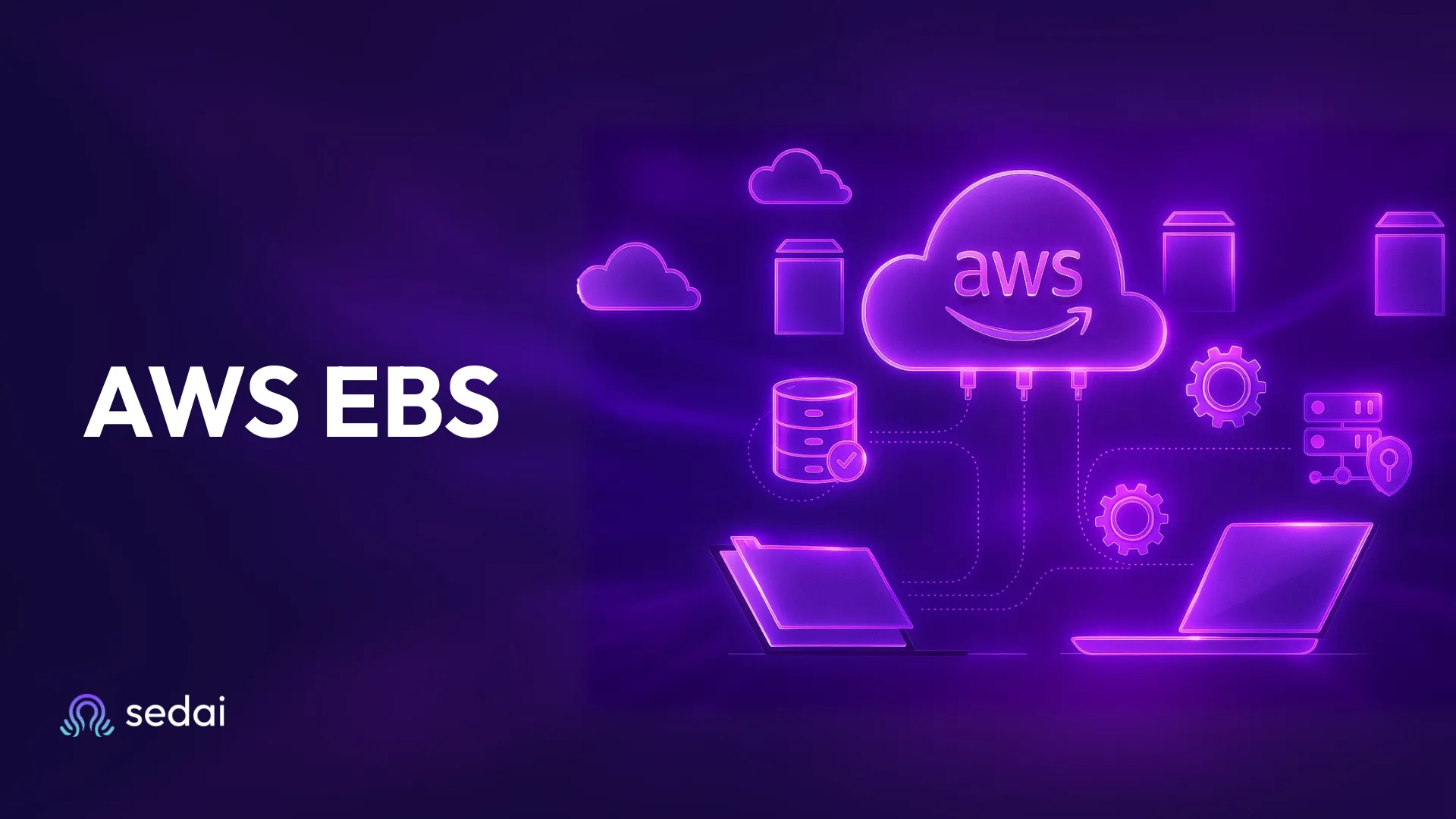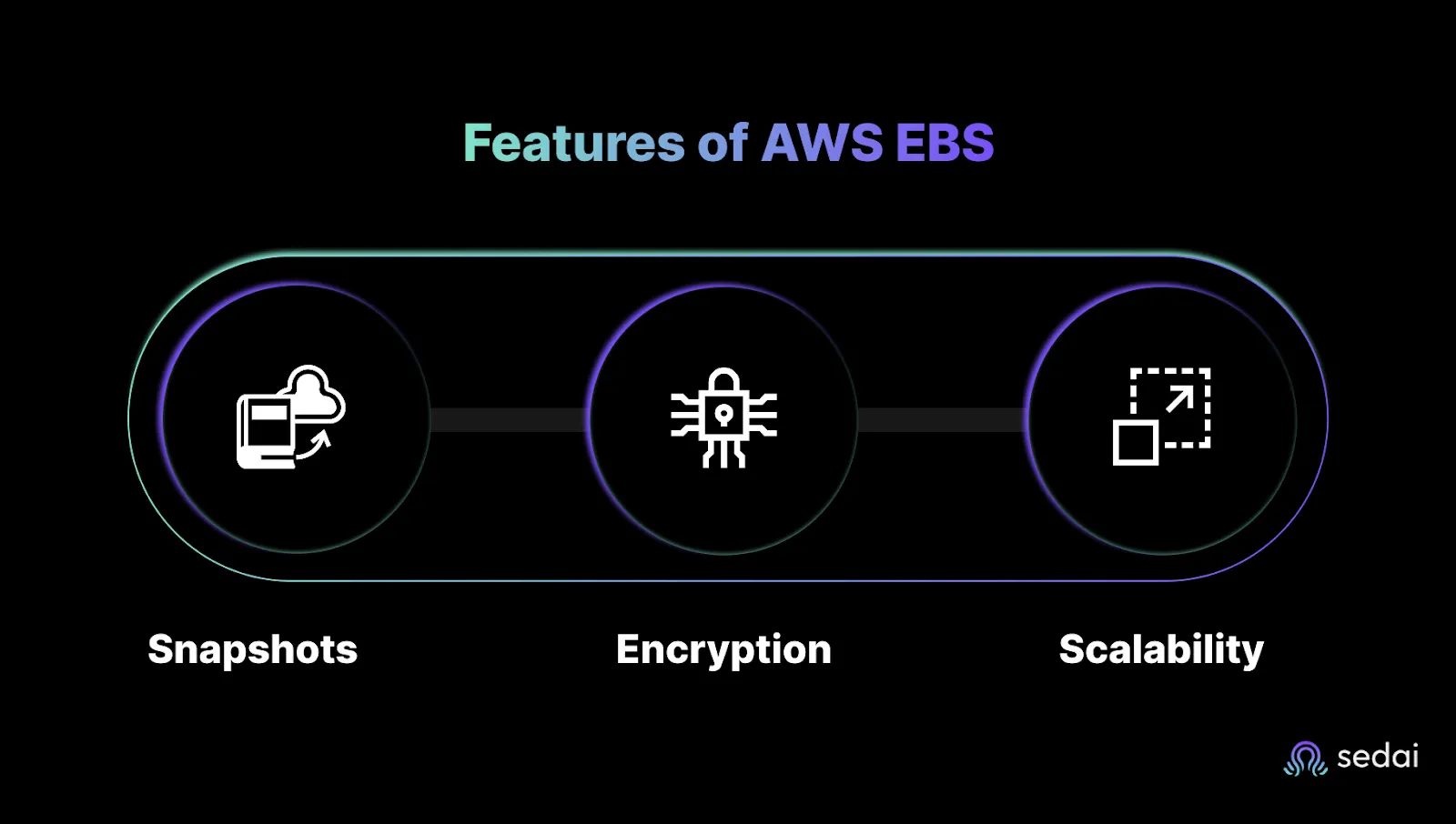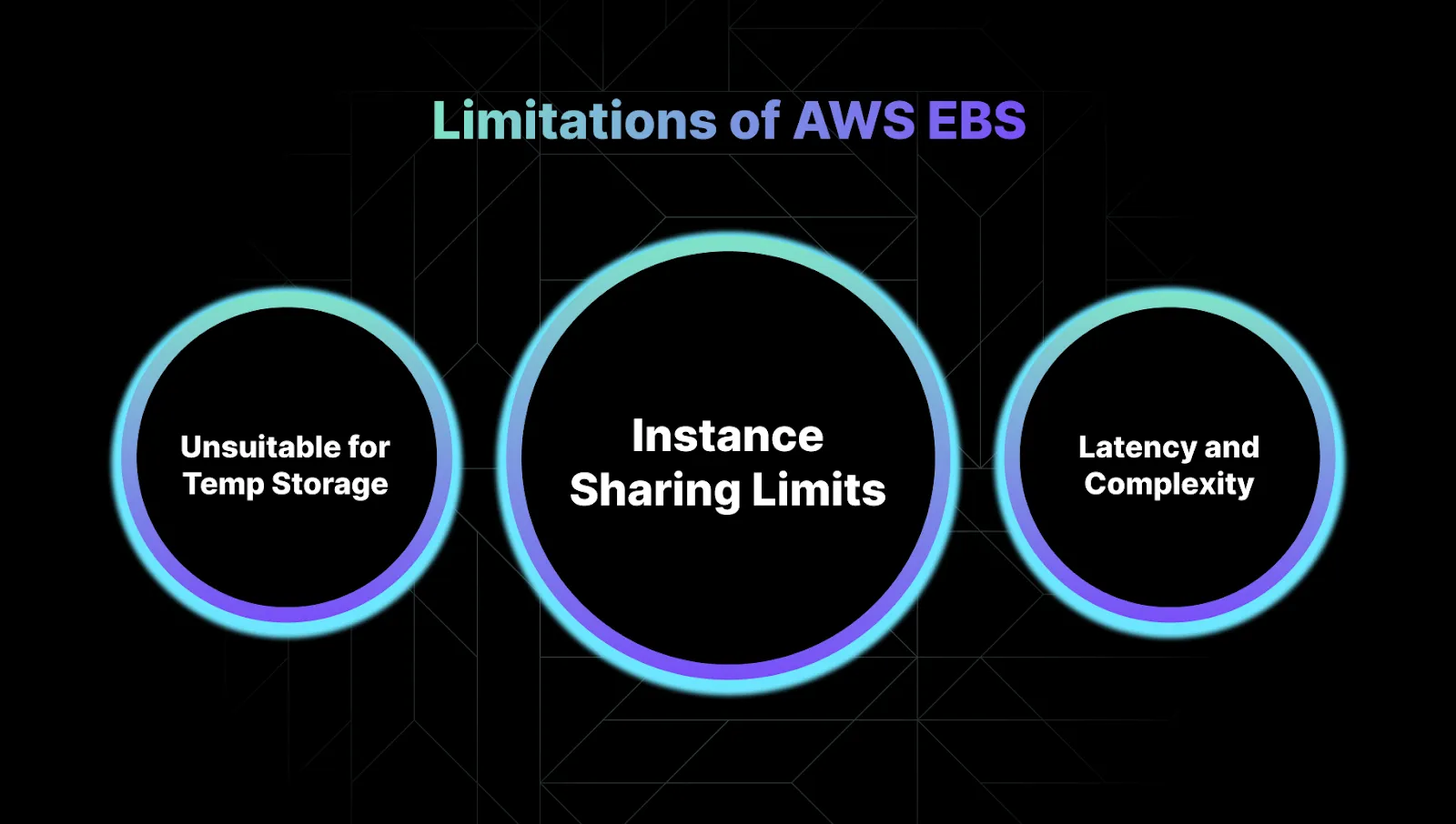Unlock the Full Value of FinOps
By enabling safe, continuous optimization under clear policies and guardrails

November 21, 2025
July 23, 2025
November 21, 2025
July 23, 2025

AWS EBS is your most critical storage layer and your biggest time sink. You're constantly managing IOPS tuning on gp3 volumes, chasing down io2 latency spikes, and finding which unattached volumes are secretly inflating your bill.
You can minimize such errors and multiple tasks by clearly understanding the basics of EBS. This guide will help you understand what AWS Elastic Block Store is and how to utilize it to its full potential.
If you’ve ever lost data because of an unexpected instance termination or struggled with slow disk performance, EBS is your fix.
EBS is block-level storage designed for Amazon EC2 instances. Unlike ephemeral instance storage, EBS volumes persist independently, so your data stays intact even if your instance crashes or terminates. It provides:

You’re managing critical workloads in the cloud, and downtime or data loss isn’t an option. AWS Elastic Block Store (EBS) gives you the reliability and flexibility you need, without the headache of managing physical storage.
Here’s how its key features keep your applications running smoothly.
No more scrambling when something goes wrong. Your data stays protected, and you control how long backups stick around.
If security is non-negotiable (and it should be), EBS keeps your data locked down without adding complexity.
You’re not stuck with over-provisioned, or worse, undersized storage. Scale up for peak traffic, then dial it back to save costs.
Next, we’ll break down the four EBS volume types, so you can pick the best one for your workload (without paying for specs you don’t need).
You’re managing critical systems in AWS, and storage performance can make or break your applications. Choose the wrong EBS volume type, and you’re stuck with sluggish databases, unpredictable costs, or overprovisioned resources.
Let’s break down the four core EBS volume types, so you can optimize performance without wasting money.
Best for: Boot volumes, dev environments, mid-tier databases, and applications needing consistent performance without breaking the bank.
Why it matters: With gp3, AWS fixed the throttling issues of gp2, giving you predictable performance without overpaying for unused capacity.
Best for: Mission-critical databases (Oracle, SAP), latency-sensitive apps, and workloads needing tens of thousands of IOPS.
When to use it: If your CFO asks why you’re paying more for storage, point to your SQL Server cluster that hasn’t crashed during peak sales.
Best for: Log processing, data lakes, and streaming workloads where throughput > IOPS.
Ideal scenario: You’re ingesting terabytes of IoT sensor data daily, and cost-per-GB matters more than lightning-fast queries.
Best for: Backups, old logs, and data you rarely touch but can’t delete.
Example: Compliance requires you to keep 7 years of audit logs. Sc1 stores them without eating your cloud budget.
Pro Tip: Monitor with CloudWatch. If your gp3 volume constantly hits IOPS limits, it’s time to upgrade to io2. To further limit data volume and focus on cost reduction on AWS cloud, Sedai AI offers autonomous optimization, which might increase efficiency and manual workload.
Now that you know the volume types, let’s talk about where EBS delivers the most value, from databases to disaster recovery.
You might have been in a similar situation where slow database queries start killing your app’s performance.
Or when a critical workload crashed because storage couldn’t keep up? AWS EBS is built for these exact moments, giving you fast, reliable block storage where it matters most.
Here’s where EBS shines:

Tired of overpaying for storage you don’t need, EBS balances cost, performance, and control so you can stop worrying about storage and focus on your apps. Up next, let's break down the common advantages and disadvantages of using AWS EBS.
You need storage that doesn’t slow you down, whether you’re running a high-traffic database, a latency-sensitive app, or just need reliable backups. AWS Elastic Block Store (EBS) gives you exactly that: virtual disks with the performance of physical drives, minus the headaches of hardware.
Here’s why engineers and architects trust EBS for critical workloads:
Moving further, let's talk about the trade-offs.
AWS EBS is powerful, but it’s not perfect. If you’re managing cloud infrastructure, you’ve probably run into these frustrations:

EBS is great for persistent block storage, but it’s not a one-size-fits-all solution. You need the right setup, and the right tools to avoid overspending or performance issues. Sedai can be your helping hand in this. Let's discuss how.
While AWS EBS provides flexible storage, managing cost, performance, and volume sprawl across environments is far from simple. Unused volumes, suboptimal storage classes, and manual tuning often add hidden overhead to already stretched teams.
To address this, some teams are integrating AI-driven tools like Sedai to bring automation into EBS management. From identifying idle volumes to right-sizing storage classes and surfacing real-time usage insights, Sedai helps reduce waste and operational drag, without the need for constant hands-on tuning.
Let’s face it, EBS gets the job done, but keeping it efficient takes more time than it should. Instead of chasing performance issues or digging through usage logs, you could be focusing on building.
Sedai brings hands-off automation to your EBS volumes. It spots idle storage, detects anomalies, and optimizes costs in real time so you don’t have to.
Join hands with Sedai and let your cloud storage take care of itself.
1. Can't AWS just manage EBS for me automatically?
Not really. While AWS provides the tools, you're still stuck manually configuring IOPS, monitoring burst balances, and cleaning up orphaned volumes. That's where autonomous solutions like Sedai come in - we automate what AWS leaves on your plate.
2. How do I know if I'm overpaying for EBS?
Look for these red flags:
3. Why does my EBS performance suddenly tank?
Usually, one of these culprits:
4. EBS vs EFS - which should I use when?
EBS when you need:
EFS when you need:
5. Can't I just write scripts to manage this?
You could... but then you're:
July 23, 2025
November 21, 2025

AWS EBS is your most critical storage layer and your biggest time sink. You're constantly managing IOPS tuning on gp3 volumes, chasing down io2 latency spikes, and finding which unattached volumes are secretly inflating your bill.
You can minimize such errors and multiple tasks by clearly understanding the basics of EBS. This guide will help you understand what AWS Elastic Block Store is and how to utilize it to its full potential.
If you’ve ever lost data because of an unexpected instance termination or struggled with slow disk performance, EBS is your fix.
EBS is block-level storage designed for Amazon EC2 instances. Unlike ephemeral instance storage, EBS volumes persist independently, so your data stays intact even if your instance crashes or terminates. It provides:

You’re managing critical workloads in the cloud, and downtime or data loss isn’t an option. AWS Elastic Block Store (EBS) gives you the reliability and flexibility you need, without the headache of managing physical storage.
Here’s how its key features keep your applications running smoothly.
No more scrambling when something goes wrong. Your data stays protected, and you control how long backups stick around.
If security is non-negotiable (and it should be), EBS keeps your data locked down without adding complexity.
You’re not stuck with over-provisioned, or worse, undersized storage. Scale up for peak traffic, then dial it back to save costs.
Next, we’ll break down the four EBS volume types, so you can pick the best one for your workload (without paying for specs you don’t need).
You’re managing critical systems in AWS, and storage performance can make or break your applications. Choose the wrong EBS volume type, and you’re stuck with sluggish databases, unpredictable costs, or overprovisioned resources.
Let’s break down the four core EBS volume types, so you can optimize performance without wasting money.
Best for: Boot volumes, dev environments, mid-tier databases, and applications needing consistent performance without breaking the bank.
Why it matters: With gp3, AWS fixed the throttling issues of gp2, giving you predictable performance without overpaying for unused capacity.
Best for: Mission-critical databases (Oracle, SAP), latency-sensitive apps, and workloads needing tens of thousands of IOPS.
When to use it: If your CFO asks why you’re paying more for storage, point to your SQL Server cluster that hasn’t crashed during peak sales.
Best for: Log processing, data lakes, and streaming workloads where throughput > IOPS.
Ideal scenario: You’re ingesting terabytes of IoT sensor data daily, and cost-per-GB matters more than lightning-fast queries.
Best for: Backups, old logs, and data you rarely touch but can’t delete.
Example: Compliance requires you to keep 7 years of audit logs. Sc1 stores them without eating your cloud budget.
Pro Tip: Monitor with CloudWatch. If your gp3 volume constantly hits IOPS limits, it’s time to upgrade to io2. To further limit data volume and focus on cost reduction on AWS cloud, Sedai AI offers autonomous optimization, which might increase efficiency and manual workload.
Now that you know the volume types, let’s talk about where EBS delivers the most value, from databases to disaster recovery.
You might have been in a similar situation where slow database queries start killing your app’s performance.
Or when a critical workload crashed because storage couldn’t keep up? AWS EBS is built for these exact moments, giving you fast, reliable block storage where it matters most.
Here’s where EBS shines:

Tired of overpaying for storage you don’t need, EBS balances cost, performance, and control so you can stop worrying about storage and focus on your apps. Up next, let's break down the common advantages and disadvantages of using AWS EBS.
You need storage that doesn’t slow you down, whether you’re running a high-traffic database, a latency-sensitive app, or just need reliable backups. AWS Elastic Block Store (EBS) gives you exactly that: virtual disks with the performance of physical drives, minus the headaches of hardware.
Here’s why engineers and architects trust EBS for critical workloads:
Moving further, let's talk about the trade-offs.
AWS EBS is powerful, but it’s not perfect. If you’re managing cloud infrastructure, you’ve probably run into these frustrations:

EBS is great for persistent block storage, but it’s not a one-size-fits-all solution. You need the right setup, and the right tools to avoid overspending or performance issues. Sedai can be your helping hand in this. Let's discuss how.
While AWS EBS provides flexible storage, managing cost, performance, and volume sprawl across environments is far from simple. Unused volumes, suboptimal storage classes, and manual tuning often add hidden overhead to already stretched teams.
To address this, some teams are integrating AI-driven tools like Sedai to bring automation into EBS management. From identifying idle volumes to right-sizing storage classes and surfacing real-time usage insights, Sedai helps reduce waste and operational drag, without the need for constant hands-on tuning.
Let’s face it, EBS gets the job done, but keeping it efficient takes more time than it should. Instead of chasing performance issues or digging through usage logs, you could be focusing on building.
Sedai brings hands-off automation to your EBS volumes. It spots idle storage, detects anomalies, and optimizes costs in real time so you don’t have to.
Join hands with Sedai and let your cloud storage take care of itself.
1. Can't AWS just manage EBS for me automatically?
Not really. While AWS provides the tools, you're still stuck manually configuring IOPS, monitoring burst balances, and cleaning up orphaned volumes. That's where autonomous solutions like Sedai come in - we automate what AWS leaves on your plate.
2. How do I know if I'm overpaying for EBS?
Look for these red flags:
3. Why does my EBS performance suddenly tank?
Usually, one of these culprits:
4. EBS vs EFS - which should I use when?
EBS when you need:
EFS when you need:
5. Can't I just write scripts to manage this?
You could... but then you're: